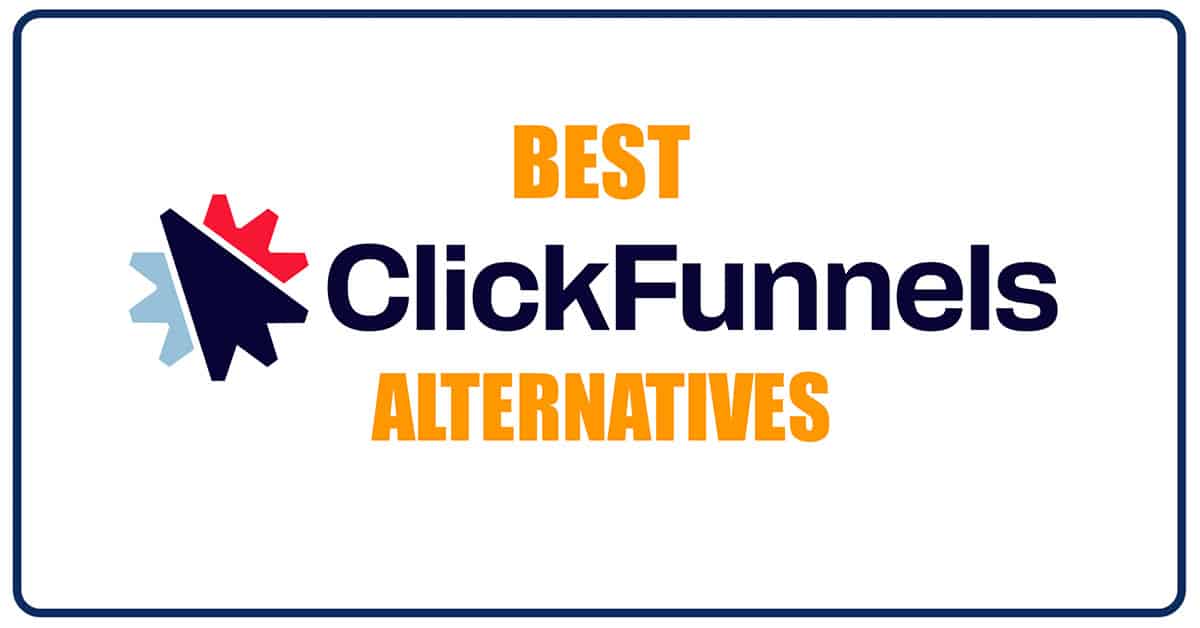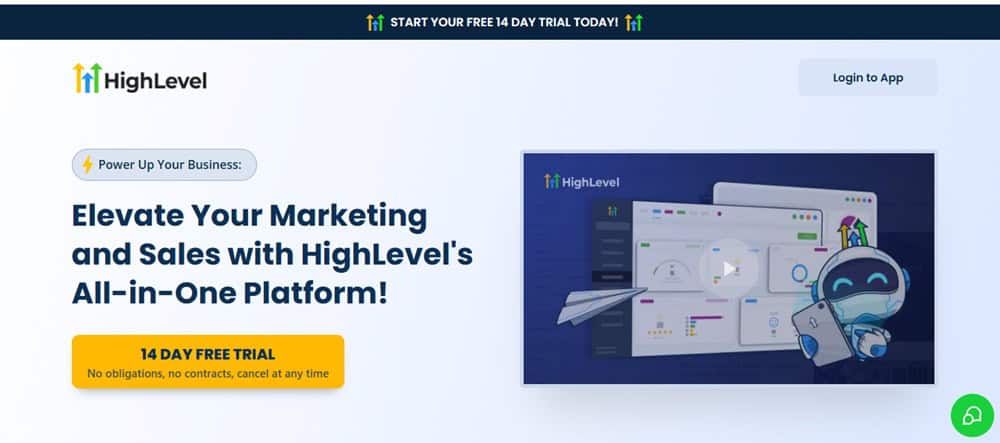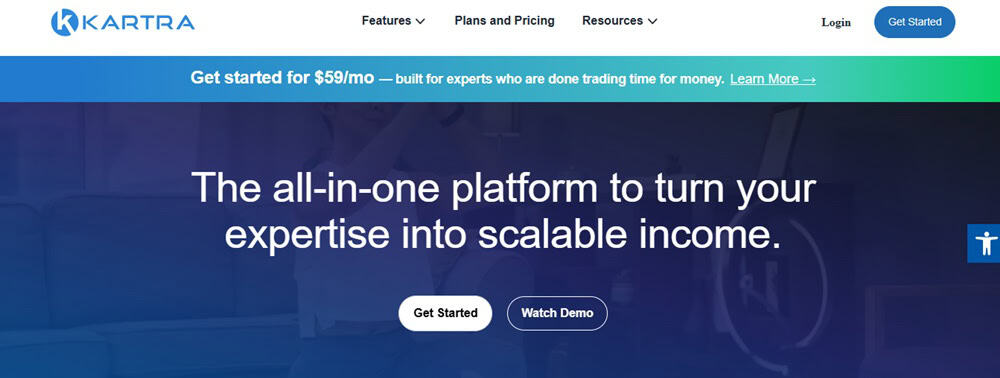KhrisDigital is supported by readers like yourself. We may earn a commission when you purchase through our links (at no extra cost to you).
Ever feel like ClickFunnels just… isn’t cutting it anymore?
Maybe it’s the clunky editor, the rising costs, or just that gut feeling that better sales funnel builders are out there. Faster, leaner, and more powerful.
Trust me, I’ve been there.
ClickFunnels has fallen over the years as the best sales funnel builder, and the numbers prove it.

Back in 2018, ClickFunnels 1.0 was the tool. I built my first six-figure funnel with it. Won affiliate contests. Tried every hack in the book. It was simple, scrappy, and it worked.
But in late 2023, I tested GoHighLevel and never looked back.
GoHighLevel is the best ClickFunnels alternative, hands down. It gives you funnels, email + SMS automation, CRM, AI, booking, and even lets you resell it as your own software. It replaces 5+ tools, costs less, and does way more. If you’re serious about growth, this is your next move.
That shift opened my eyes to a whole new wave of ClickFunnels alternatives. Some are cheaper. Some do way more. Some just feel better to build with.
So, if you’re hunting for ClickFunnels substitutes or serious competitors, you’re in the right place.
15 Best ClickFunnels Alternatives & Competitors
| Software | Free Trial Period | Starting Price |
|---|---|---|
| GoHighLevel | 14 days | $97/month |
| Kartra | 30 days | $59/month |
| Systeme.io | Free plan available | $17/month |
| GetResponse | Free plan available | $19/month |
| SamCart | 7 Days | $79/month |
| ThriveCart | None | $495 one-time |
| Thinkific | 30 days | $49/month |
| Podia | 30 days | $39/month |
| Kajabi | 14 Days | $71/month |
| Kit (FKA ConvertKit) | 14 Days | $39/month |
| Wix | Free plan available | $17/month |
| HubSpot | Free Plan available | $15/seat/month |
| Shopify | 3 Days | $5/month |
| OptimizePress | 14 Days | $99/year |
| CartFlows | Free plugin | $189/year |
1. GoHighLevel — The Best ClickFunnels Alternative (Hands Down)
If you’re still wrangling ClickFunnels and duct-taping it to a dozen other tools, it’s time for a reality check; you’re working way too hard.
Let me put you on to something better.
GoHighLevel launched in 2018 as a behind-the-scenes weapon for marketing agencies, but it didn’t stay a secret for long.
Once I tried it in late 2023, that was it. No turning back. It was like going from a flip phone to an iPhone overnight.
With GoHighLevel, you don’t just build funnels. You build businesses. You automate chaos. You clone results. You own the system.
What You’ll Love About GHL (aka Features You’ll Actually Use)
- AI Employee: You know that assistant you wish you could afford? Yeah, this is it. From handling DMs to following up with leads at 2 am, your HighLevel AI Employee works around the clock without ever asking for PTO.
- GoHighLevel Snapshots: Imagine copying an entire setup — funnels, automations, calendars — and pasting it into a new client account in seconds. It’s like Control+C for your business systems. GoHighLevel snapshots are your total agency cheat code.
- White-Label SaaS Reselling: Want to sell your own ClickFunnels competitor? You can. Slap your logo on it, set your pricing, and start stacking that sweet, sweet monthly recurring revenue.
- All-in-One Funnel + CRM + Calendar: One tab. One login. One platform that handles everything from lead gen to follow-up. You’ll wonder how you ever lived without it.
- Automated Follow-Ups (Email, Text, VM): Leads ghosting you? Not anymore. Set up workflows once and let GoHighLevel do the chasing, with emails, texts, and even pre-recorded voicemails.
- Website + Blog Builder: This isn’t just a funnel tool. You can build full websites and publish blog content too. More visibility, more SEO juice, more credibility, all in one spot.
- Reputation Management Tools: Want more 5-star reviews? GoHighLevel automatically asks your customers for them, responds to reviews, and keeps your local ranking looking fresh.
- Booking System That Gets You Paid: Let clients book, reschedule, and even pay upfront, all without the back-and-forth emails. It’s like having a front desk, minus the salary.
What Makes HighLevel a No-Brainer (Pros)
- Replaces 5+ tools in one move: Save your sanity and a few hundred bucks a month by running it all from one place.
- Workflows that actually work: You build it once, and it handles every lead like clockwork.
- Perfect for agencies or serial builders: Snapshots + white-label = scale on autopilot.
- AI that pulls real weight: The AI tools write, reply, and engage like a real team member.
- Massive community + constant upgrades: You’re never stuck. There’s always a new feature or helpful post in the group.
- You can build your OWN ClickFunnels competitor: Resell GoHighLevel as your own SaaS platform and finally start stacking that passive income.
Where GoHighLevel Might Trip You Up (Cons)
- It’s not plug-and-play pretty: Don’t expect a cartoonish UI. It’s functional first. (But once it clicks, it clicks.)
- Takes time to learn the ropes: You’ll need a couple of days to get comfy, but after that, it’s smooth sailing.
- No free plan to test-drive: You’ve got to invest upfront, but if you’re serious, it pays for itself fast.
GoHighLevel Pricing (What You’re Looking At)

- Starter Plan at $97/month: Just you, building your funnels, automating your flow. Perfect if you’re solo or just starting.
- Unlimited Plan at $297/month: Need client sub-accounts? This is where it gets powerful. Manage everything from one dashboard.
- SaaS Pro Plan at $497+/month: Go full white-label. Sell it as your own software, build your own pricing, and start stacking MRR.
Check out my complete GoHighLevel review here.
2. Kartra — The “Business in a Box” ClickFunnels Alternative
If GoHighLevel feels like hiring a whole team, Kartra is like renting a fully stocked office with a desk, phone, secretary, espresso machine, all ready to go the moment you walk in.
Kartra provides websites, funnels, email marketing, memberships, a helpdesk, and calendars. It’s all right there, waiting.
It launched in 2018 and quickly built a cult following among solopreneurs, course creators, and service providers who sought a professional setup without the technical stress.
If you love the idea of everything being connected and speaking the same language, Kartra is your next move.
What You’ll Get With Kartra (Features That Make Sense)
- Drag-and-Drop Funnel Builder: Build smart funnels fast without hunting for templates. Every piece fits — pages, emails, products, and automations are baked in.
- Kartra Mail (Email + Automation): Set up behavior-based automations, tag users, and fire off sequences like a pro, no extra email platform needed.
- Kartra Membership Site Builder: Launch your courses or gated content with built-in access levels, content drip, and beautiful layouts.
- Video Hosting with Built-In CTAs: Upload videos and add clickable CTAs right inside them. No need for Vimeo or Wistia anymore.
- Calendar + Appointment Scheduling: Let clients book time with you directly, with reminders, buffers, and integrations included.
- Checkout + Cart System: Sell anything, digital or physical, with upsells, downsells, and recurring billing. No third-party checkout needed.
- Helpdesk + Ticketing System: Built-in customer support center to keep things clean and professional without paying for another tool.
- Affiliate Management Center: Recruit, track, and pay affiliates directly from your dashboard. Everything’s native, nothing to patch together.
What You’ll Love About Kartra (Pros)
- Truly all-in-one: Everything you need under one roof, no Frankenstein stack required.
- Smooth, visual interface: Clean and beginner-friendly with less clutter than most platforms.
- Strong for digital products and memberships: Perfect if you’re selling courses, coaching, or info products.
- Built-in video hosting and email: Saves you from extra subscriptions like ConvertKit or Wistia.
- Solid automations and tagging: Set up smart journeys and personalized emails easily.
- Great for solopreneurs: You don’t need a tech team or VA to make Kartra work.
What’s Not So Great About Kartra (Cons)
- Limited customization: Kartra templates are lovely, but design flexibility isn’t as broad as some platforms.
- Can feel sluggish at times: Page load speed and backend speed could be snappier.
- Learning curve with automation logic: If you’re new to behavior-based marketing, it might take a minute to click.
How Much Will Kartra Cost You?
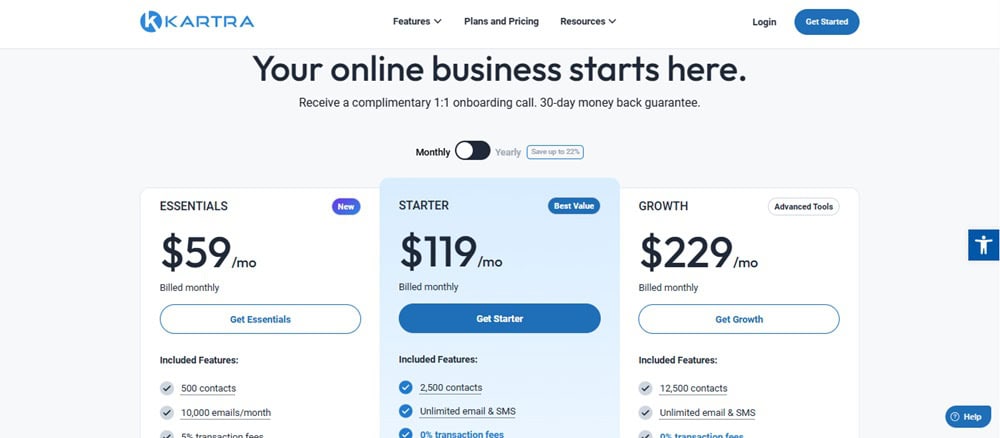
- Essentials at $59/month ($52/month when billed annually): This is perfect if you’re starting. It includes the basics for launching and running a small business funnel.
- Starter at $119/month ($99/month when billed annually): This is great for solo creators or small teams ready to scale with more leads, emails, and bandwidth.
- Growth at $229/month ($199/month when billed annually): This gives you room to expand with advanced features, more automations, and higher limits.
- Professional at $549/month ($429/month when billed annually): This is built for serious businesses that need max power, priority support, and everything Kartra offers.
Read my complete Kartra review here.
3. Systeme.io (Best Free ClickFunnels Alternative)
If you’re running lean, just getting started, or want a ClickFunnels-style platform without the monthly gut-punch to your wallet, Systeme.io is your golden ticket.
This is the best free alternative to ClickFunnels, hands down.
It’s clean, simple, and powerful. And most importantly, it won’t cost you a dime to get started.
What Makes Systeme the Best Free Alternative to ClickFunnels?
- Drag-and-Drop Funnel Builder: Build high-converting funnels without touching a single line of code. It’s beginner-proof and still gets results.
- Unlimited Email Marketing (on paid plans): No need for separate email tools. Set up automations, send broadcasts, and nurture your list right inside your dashboard.
- Online Course + Membership Hosting: Sell your expertise. Upload your lessons, manage access, and deliver a clean course experience. All built in.
- Evergreen Webinar Funnels: Run automated webinars that feel live. Perfect for selling on autopilot while you sleep.
- Built-In Affiliate Management: Turn your fans into salespeople. Create affiliate programs, track commissions, and grow with zero ad spend.
- Sales Page + Checkout Builder: Accept payments, offer upsells/downsells, and deliver products without needing extra tools like SamCart or ThriveCart.
- Automation Rules & Workflows: Tag users, move them between funnels, trigger emails, and build follow-up journeys, all based on their behavior.
- Blog + Website Builder: Build authority and drive organic traffic with a simple blogging interface that’s SEO-friendly and ready to go.
What You’ll Love About Systeme
- You can launch a legit business for free: You could run a whole funnel, email list, and course without spending a dollar.
- It’s built for simplicity: Nothing feels bloated. Everything is where it should be, and it just works.
- No annoying integrations: You don’t have to glue it to five other tools to do basic marketing.
- Free plan actually lets you sell: Most free tools limit you, but Systeme lets you earn from day one.
- Fast setup, clean interface: You’ll have your first funnel live in an hour, even if you’ve never built one before.
- Super affordable when you scale: Even their highest plan is cheaper than ClickFunnels’ basic.
What’s Not So Great About Systeme
- Design limitations: Templates look clean, but they’re not as customizable as something like ClickFunnels or Webflow.
- Not ideal for big teams or agencies: There’s no client account separation or multi-user roles unless you start hacking it.
- Reporting is basic: You’ll get the top-line numbers, but deep analytics are pretty minimal.
How Much Does it Cost to Use Systeme.io?
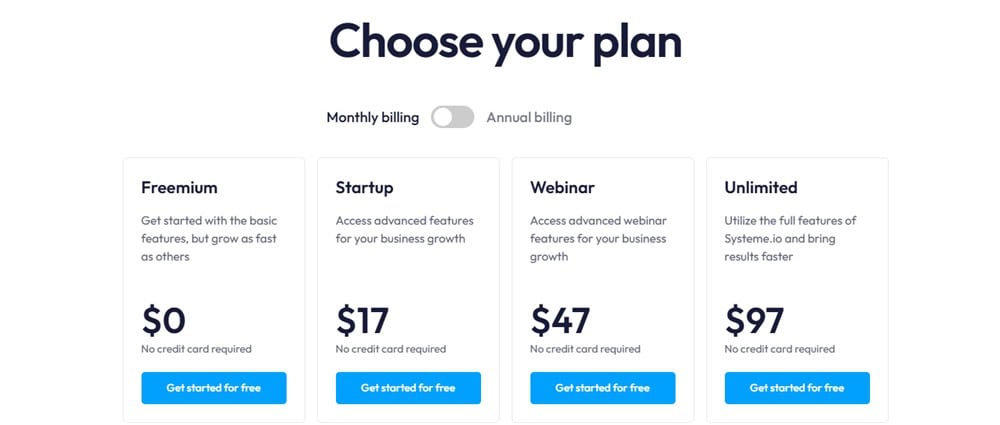
- Freemium at $0/month: You can build up to three sales funnels, send emails to up to 2,000 contacts, and sell unlimited products. Zero cost to launch.
- Startup at $17/month: Build up to ten funnels and send emails to 5,000 contacts. Ideal when you’re gaining traction.
- Webinar at $47/month: Build up to 50 funnels, and add automated webinars and bigger limits for scaling creators.
- Unlimited at $97/month: No limits on anything. Funnels, blogs, emails, products, automations. Everything is unlocked so that you can go big.
4. GetResponse — Best for Email-First Marketers Who Want Funnels Too
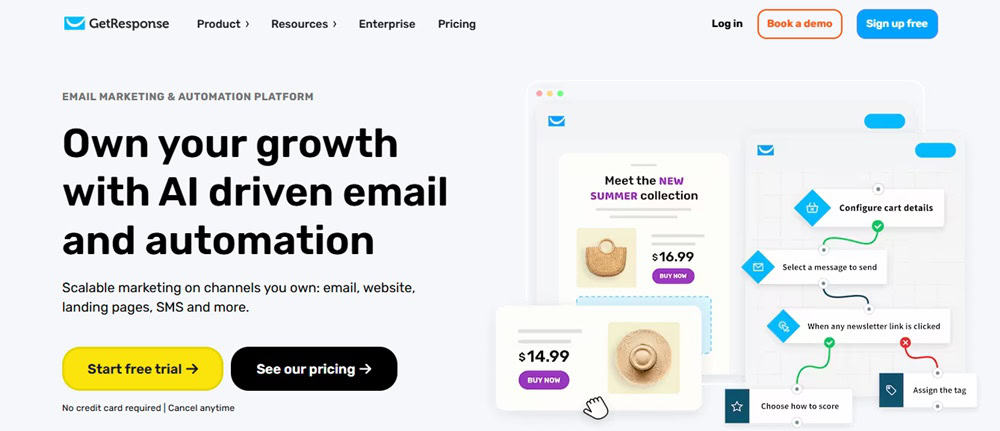
If you’ve built your business around email and you’re tired of cobbling together tools that never quite click, GetResponse is made for you.
It started as an email platform, but now? It’s evolved into a powerful ClickFunnels alternative that gives you funnels, landing pages, automations, ecommerce, webinars, and yes, it still crushes the email side.
This is for creators, coaches, and solopreneurs who want a powerful funnel builder without sacrificing advanced email marketing capabilities.
What Makes GetResponse a Great ClickFunnels Substitute
- AI Funnel Builder That Writes + Builds for You: Describe your goal, list growth, product sales, webinar signups, and GetResponse uses AI to generate the funnel layout and the copy.
- Marketing Automation That Feels Effortless: Trigger emails, move subscribers, assign tags, all based on what your users actually do.
- High-Converting Landing Page Templates: Choose from dozens of optimized templates for opt-ins, sales pages, or thank-you pages.
- Built-in Webinar Platform: Run live webinars, on-demand replays, or automated events all from inside your account.
- Complete Email Marketing Suite: Get advanced segmentation, behavior tracking, automation rules, and A/B testing. It’s built to grow with you, from your first 500 subscribers to 500,000.
- Sales Funnels with Checkout + Upsells: Create entire funnels that include product pages, upsells, order bumps, and payments, no need for extra ecommerce tools.
- List-Building Tools (Popups, Forms, Bars): Add exit popups, slide-ins, or sticky bars to capture leads from your blog, store, or landing pages.
- AI-Powered Email + Newsletter Generator: Out of ideas? Let AI write your subject lines, email copy, and even newsletters based on your campaign goal or audience behavior.
What I Love About GetResponse (Pros)
- Email + Funnels in One Powerful Tool: You get pro-level email tools and a funnel system under one roof.
- Marketing Automation Is Next-Level: You can create complex user journeys based on actions like clicks, site visits, or purchases, and it all feels intuitive, not overwhelming.
- Webinar Hosting Saves You Extra Subscriptions: GetResponse lets you run webinars without paying for Zoom or other webinar tools.
- Ideal for Selling Digital + Physical Products: Whether you’re running a course or shipping t-shirts, the ecommerce setup is clean, fast, and integrated with your funnels.
- Solid Deliverability + List Management: Your emails actually land in inboxes. Plus, you can easily segment, clean your list, and stay GDPR/compliance-safe.
- AI Tools That Actually Save You Time: From subject line suggestions to complete email sequences, the AI inside GetResponse helps you move faster.
What I Don’t Like About GetResponse (Cons)
- Landing Page Builder is Slightly Clunky: While the templates are great, the landing page builder itself feels a bit slow compared to newer platforms.
- Ecommerce Features are Limited for Large Stores: If you’re running a full-blown ecommerce store with hundreds of SKUs, this might not cut it. It’s best for solopreneurs with a small product catalog.
- Webinar Capacity Depends on Plan: If webinars are your main revenue stream, you’ll probably need to upgrade sooner rather than later.
How Much Does GetResponse Cost?
- Free Plan at $0/month: You get up to 500 contacts, email broadcasts, one landing page, signup forms, and a website builder. A solid starting point to test things out.
- Starter Plan at $19/month for 500 Contacts: This plan includes autoresponders, unlimited landing pages, popups, basic segmentation, and more automation.
- Marketer Plan at $59/month for 500 Contacts: This includes a complete automation builder, advanced segmentation, sales funnels, abandoned cart emails, and e-commerce integrations.
- Creator Plan at $69/month for 500 Contacts: This is tailored for course creators and coaches. It includes webinar hosting, AI course builder, and premium newsletter tools.
Note: Pricing varies based on list size; expect to pay more as your contacts grow.
5. SamCart — Best for Creators Selling Digital Products & Courses
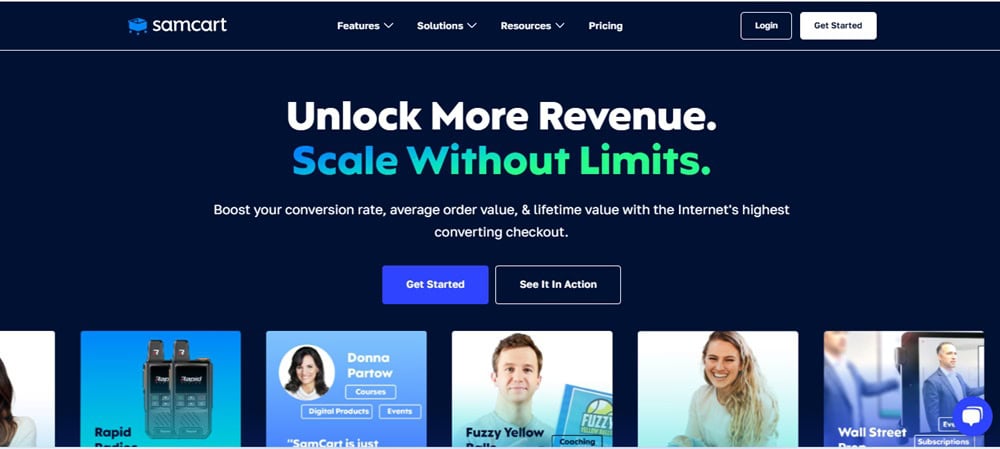
If selling stuff is your main game and you want your checkout pages to earn while you sleep, SamCart’s built for you.
It doesn’t try to be everything, and that’s a good thing.
SamCart focuses on what actually brings in cash: sales pages, checkouts, upsells, order bumps, and getting people to hit that “buy” button. It’s ridiculously easy to set up, and the checkout experience is buttery smooth for your buyers.
What Makes SamCart an Excellent ClickFunnels Alternative
- “Checkout Anywhere” Options (Embed, Express, Slide, Sales Pages): You’re not tied to a single template or platform. Want to sell from your blog, your own site, or via custom pages? SamCart lets you drop in checkout points wherever your customers already hang out.
- 1‑Click Upsells & Order Bumps: Once someone’s about to pay, you can offer them extras with one click.
- Cart Abandonment + Subscription Saver: When people leave before purchasing, or cancel a subscription, SamCart helps you chase them back. “Hey, forgot something?” nudges, recovery flows, etc.
- Drag‑and‑Drop Page + Template Library: You don’t need a designer to make things look sharp. And that means fewer excuses, faster live pages.
- Multiple Payment Options + Digital Wallets: Let your customers pay how they want, Apple Pay, Google Pay, credit cards, etc. Fewer barriers = more sales.
- Affiliates & Custom Integrations: SamCart has an affiliate center, and you can integrate with other tools (email, membership, fulfillment) so you don’t have to build everything yourself.
- Advanced Reporting & Real‑Time Analytics: See what’s converting, which pages are leaking customers, which upsells are working, so you can fix leaks & double down on wins.
- Unlimited Products, Courses, Pages, and Students: Whether you’re selling one ebook or a dozen courses + physical products, you won’t hit feature caps.
What You’ll Love About SamCart (Pros)
- All features from day one: No “upgrade to unlock this killer feature.” You get everything — upsells, order bumps, affiliate tools — right out the gate.
- Checkout optimized for conversions: The design, speed, payment options, and cart abandonment tools are all tuned to make buying as frictionless as possible.
- Flexible checkout locations: Because of “Checkout Anywhere”, you show checkout where people already are (blog, content, your site).
- Scale with your business: As your sales go up, your billing adjusts.
- Strong support & ongoing updates: SamCart promises that every new feature is included for everyone, so you benefit from constant improvements. Also, their support and onboarding help make sure you hit the ground running.
- Zero extra transaction fees by SamCart: You don’t pay SamCart a cut of every sale.
What You Won’t Like About SamCart (Cons)
- Pricing increases with revenue: While the feature set stays the same, once your sales cross certain thresholds, your monthly bill increases.
- Limited “funnel building” outside the checkout: You don’t get a complete course builder + membership site + blog + community in one place (or deep CRM features).
- Design customization has bounds: Templates are solid and relatively flexible, but if you need ultra‑custom layouts or very advanced theming, you might feel constrained by what the templates allow.
How Much Does SamCart Cost?
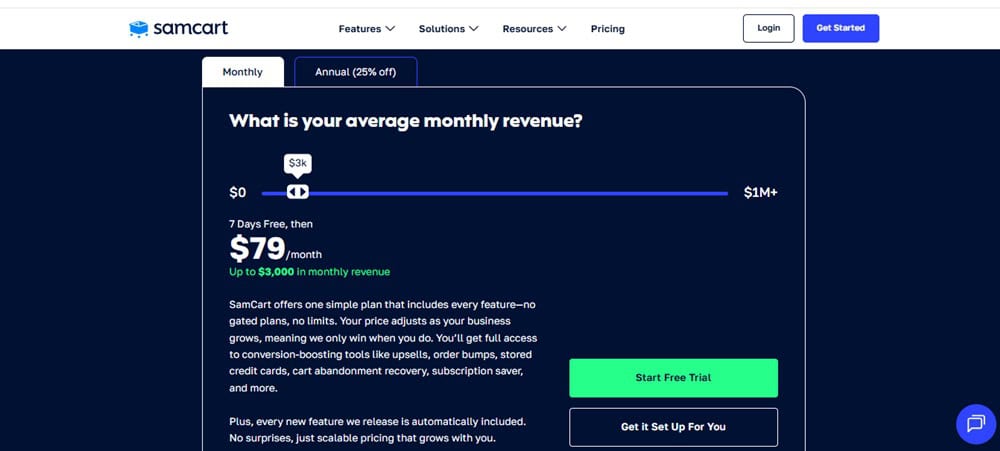
SamCart has one all-inclusive plan. You get every feature SamCart has to offer, no matter what. No plans, no gated features. Just every advanced tool to get more customers, buying more, more often.
Pricing starts at around $79/month for up to $3,000 in Monthly Revenue, and your cost will scale up based on your revenue.
6. ThriveCart
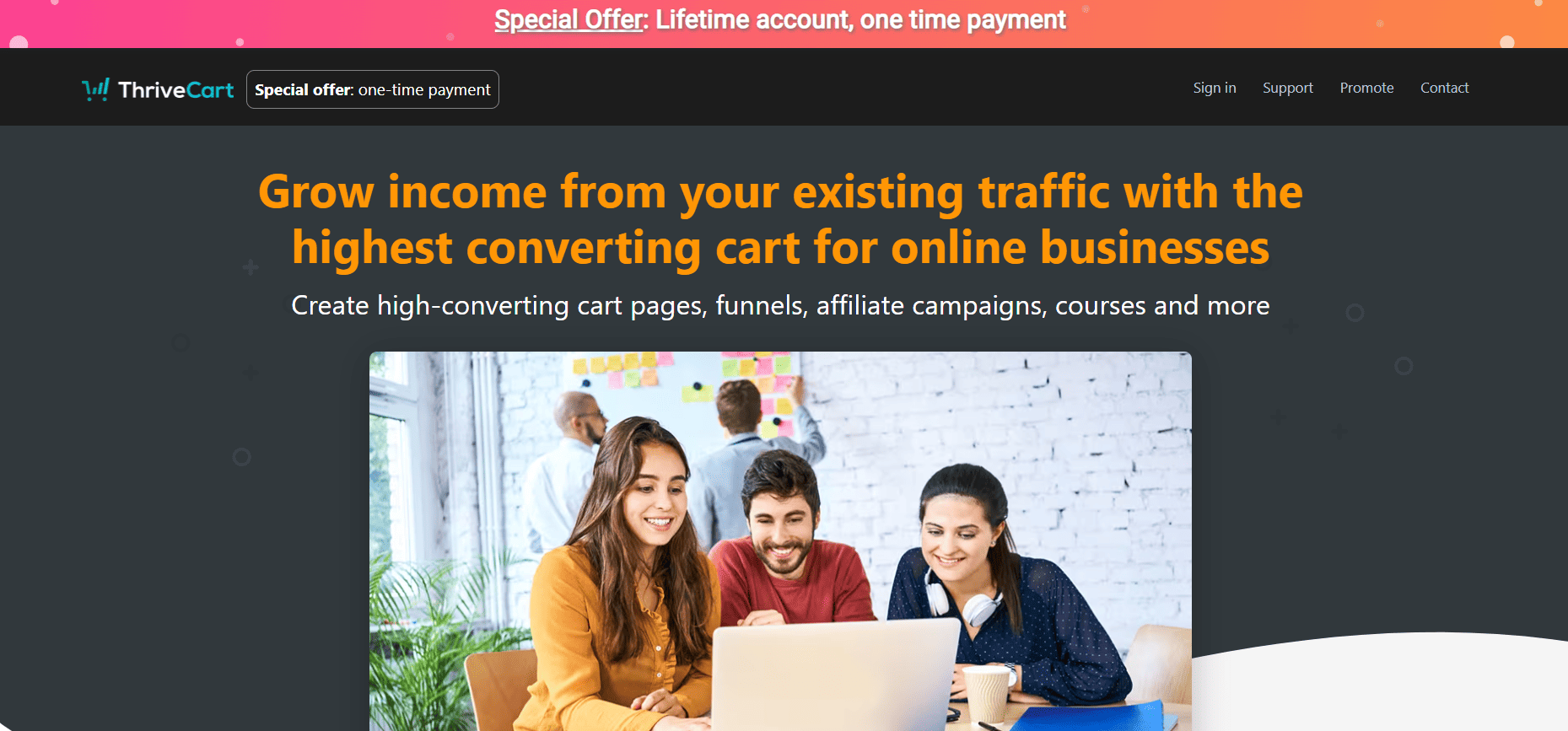
If you hate monthly fees but still want a powerful tool that helps you sell like a pro, ThriveCart was practically made for you.
It’s laser-focused on conversions, with everything from sleek checkout pages to bump offers, upsells, affiliate tracking, and even course delivery baked in.
And the best part? You pay once, and that’s it. No recurring fees drain your wallet every month.
What Makes ThriveCart a Strong ClickFunnels Competitor?
- One-Time Payment for Lifetime Access: Pay once and use it forever. No sneaky upsells, no creeping costs.
- High-Converting Checkout Pages: You get tested, clean, mobile-friendly templates built to close. Whether it’s a $27 ebook or a $997 coaching program, ThriveCart makes it easy to sell.
- 1-Click Upsells & Bump Offers: Want to boost order value without annoying your buyer? Add upsells and bump offers with zero friction — and increase your revenue per customer on autopilot.
- Powerful Subscription & Payment Plan Options: Sell one-time, recurring, split-pay, trials, and even pay-what-you-want offers. You can build any pricing structure your business model needs.
- Affiliate Management Built-In: Launch your own affiliate program and turn happy customers into promoters. Track clicks, payouts, and performance all from the same dashboard.
- Dunning + Cart Abandonment Tools: ThriveCart follows up with customers who bail at checkout or fail a payment. That means less lost revenue and more recovered sales.
- Built-In Course Platform (ThriveCart Learn): You can host and deliver your digital products or courses inside ThriveCart, no extra platform required.
- Deep Integrations with Your Favorite Tools: Easily connect to email platforms, CRMs, and membership tools.
What You’ll Love About ThriveCart (Pros)
- No monthly fees, ever: This is rare. You pay once, and you’re done.
- Checkout pages are clean and high-converting: They’re designed for one thing: getting people to buy. And they’re fast, no fluff, no distractions, just sales.
- Order bumps and upsells are seamless: You can add these with zero tech hassle.
- Subscription logic is next-level: If you sell memberships or payment plans, ThriveCart gives you total control, including trials, dunning, and pro-rated upgrades/downgrades.
- Affiliate program included at no extra cost: No need for a third-party affiliate system. It’s already built in, and it’s rock solid.
- ThriveCart Learn is actually good: The course platform is fast, simple, and flexible enough to launch real digital products or training hubs.
What I Don’t Like About ThriveCart (Cons)
- The UI feels outdated: It works fine, but compared to newer platforms, the backend can feel clunky and stuck in 2018.
- Limited page design flexibility: You can’t fully customize layouts like you would in Webflow or ClickFunnels. What you gain in simplicity, you lose in visual control.
- No native funnel builder: While it’s excellent at checkout flows, there’s no visual funnel map or “drag-and-drop” experience for full funnel-building.
How Much Does ThriveCart Cost?
- Lifetime Plan with One-Time Payment of $495: Get access to all core features, upsells, bump offers, integrations, and ThriveCart Learn. No monthly fees, ever. A rare deal in a monthly world.
- Pro Add-On ($295/year): This adds affiliate management, subscription saver, JV contracts, and advanced user permissions. If you’re serious about scale, it’s worth grabbing.
You may also enjoy My Thrivecart Review post.
7. Thinkific — Best for Course Creators

If you’ve got knowledge to share and want to build a legit course business around it, Thinkific is where you make it real.
This isn’t just about selling info products.
It’s about creating a student experience that feels premium, branded, and 100% yours. Thinkific gives you the tools to teach, engage, and sell, without sacrificing ownership or creative control.
What Makes Thinkific a Great ClickFunnels Alternative
- Drag-and-Drop Course Builder That Feels Effortless: Upload videos, add quizzes, organize modules, all without tech headaches.
- Customizable Student Experience: From welcome emails to completion pages, you shape how students feel every step of the way.
- Branded Website + Custom Domain: Launch your course under your own brand, not someone else’s. Your domain, your logo, your vibe, it all screams “pro.”
- One-Time Payments, Subscriptions, or Payment Plans: Sell your course in a way that makes sense for you. High-ticket? Monthly membership? Pay-what-you-want? Thinkific handles it all.
- Built-In Community Features: Create course discussions, private communities, and space for engagement without relying on Facebook groups.
- Drip Content + Course Progress Tracking: Keep students coming back with time-released content and clear progress indicators that motivate them to finish what they started.
- Advanced Analytics + Student Insights: See who’s buying, who’s finishing, who’s ghosting, and use that data to improve your course or launch smarter next time.
- Complete Control Over Pricing, Refunds, and Access: No marketplace rules, no forced discounts, no platform control. You set the rules. You keep the profits.
What I Love About Thinkific (Pros)
- Built specifically for education: Unlike funnel builders that bolt on course delivery, Thinkific is made for teaching.
- You own the experience: From branding to pricing to domain, this is your platform. No Thinkific branding unless you choose it.
- Flexible pricing and sales models: Whether you’re selling $49 mini-courses or $2K coaching programs, Thinkific lets you structure offers exactly how you want.
- No transaction fees on paid plans: More of your money stays in your pocket, no extra cut taken from your hard-earned sales.
- High reliability and security: Your content stays safe, your students get 24/7 access, and the platform is rock solid.
- Excellent support and onboarding: Their guides, tutorials, and human support make it easy to get your first course live, even if you’ve never built one before.
What I Don’t Like About Thinkific (Cons)
- Marketing tools are limited: You’ll need to integrate with third-party email tools or funnel builders to run serious marketing campaigns or automations.
- The design tools can feel restrictive: You can customize quite a bit, but it’s not a complete web builder.
- Free plan has heavy limitations: You can get started for free, but fundamental business tools (like communities, certificates, or bulk enrollments) require upgrading.
How Much Does Thinkific Cost?
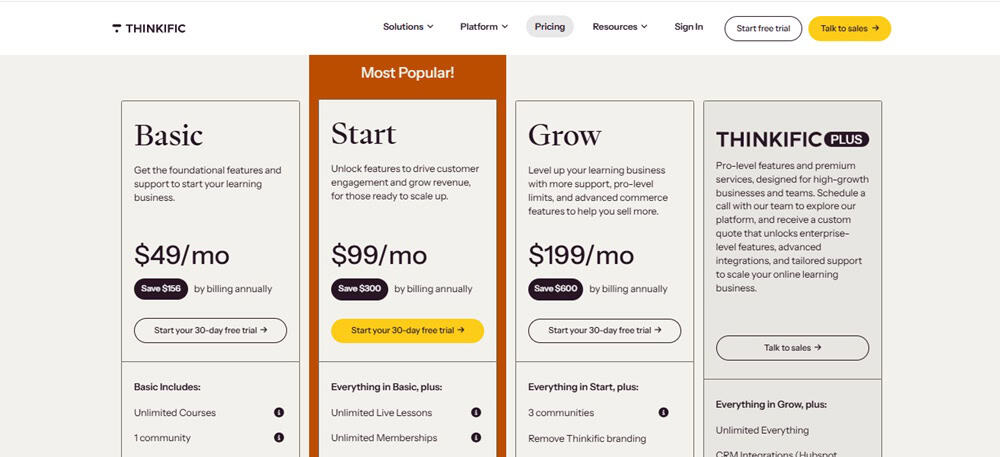
- Basic at $49/month ($36/month billed annually): You get unlimited courses, coupons, drip content, and student email integration. Perfect for first-time creators ready to launch.
- Start at $99/month ($74/month billed annually): This plan adds live lessons, certificates, communities, advanced course delivery features, and affiliate selling tools.
- Grow at $199/month ($144/month billed annually): This is designed for scaling. Includes advanced segmentation, API access, assignments, and priority support.
- Thinkific Plus: This is a custom plan and it offers pro-level features and premium services, designed for high-growth businesses and teams.
8. Podia
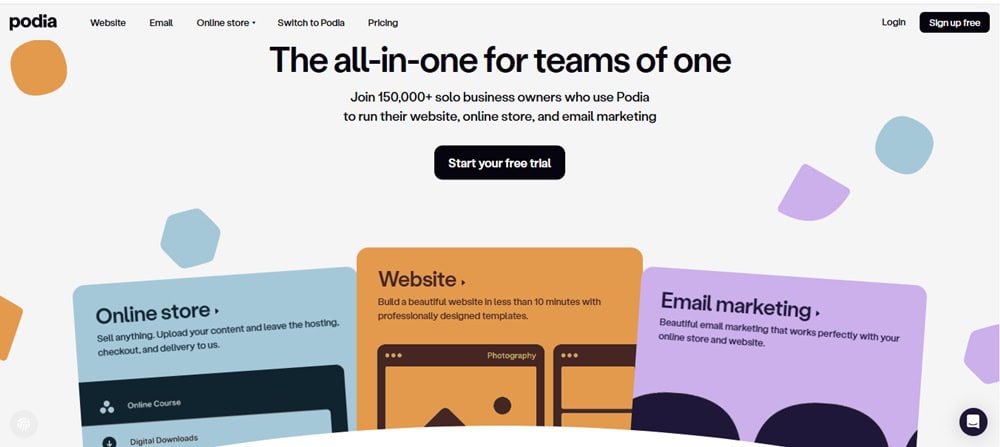
If you’re tired of platforms that make you feel like you need a PhD in funnels to sell an ebook, meet Podia.
This is your go-to if you’re a creator, coach, writer, or side hustler who wants to launch fast, sell, and keep everything under one roof. Podia handles your products, emails, checkout, courses, community, and even your website, all in a way that actually makes sense.
You’ll spend less time fiddling with tech and more time getting paid for what you know.
What Makes Podia A Great ClickFunnels Competitor
- All-in-One Platform for Digital Products: Sell courses, digital downloads, coaching, webinars, and memberships, all from one clean dashboard.
- No Transaction Fees on Paid Plans: Podia doesn’t take a cut of your sales once you’re on a paid plan. More profit, fewer platform fees.
- Built-In Email Marketing: Send broadcasts, automate campaigns, and tag your subscribers without needing ConvertKit or Mailchimp on the side.
- Drag-and-Drop Website Builder: Launch a clean, professional-looking site in minutes. No code, no designer, no problem.
- Community Feature to Keep Your Audience Close: Host your own private community (like a Facebook group, without the algorithm drama).
- Live Chat + Messaging With Customers: Answer questions, close sales, and support students directly inside your platform.
- Flexible Payment Options: Offer one-time pricing, payment plans, subscriptions, or free products. Whatever matches your offer, Podia supports it.
- Instant Payouts via Stripe + PayPal: No holding periods. You get paid immediately, which makes a huge difference when you’re bootstrapping or scaling solo.
What I Love About Podia (Pros)
- Ridiculously easy to use: Everything’s drag-and-drop, clean, and beginner-friendly.
- No nickel-and-diming: Once you’re on a paid plan, you’re not hit with hidden fees, transaction cuts, or annoying upsells.
- All your products live in one place: Courses, downloads, coaching, and community. Your audience can access everything from one simple login.
- Built for creators, not techies: Podia’s features are designed around the way you work, not the way a software engineer thinks you should work.
- Live support that’s actually helpful: Got a question? Their support team is fast, friendly, and human. They even have a chat bubble right in your dashboard.
- Community tools built in: Build your own community space and tie it to your offers.
What I Don’t Like About Podia (Cons)
- Design customization is limited: The templates are clean, but not super flexible.
- Email automation is pretty basic: You can send sequences and broadcasts, but advanced triggers, conditions, or behavioral automations are limited.
- Funnels aren’t its strong suit: Podia lets you build simple sales flows, but it’s not built for multi-step, logic-heavy funnels like ClickFunnels or GoHighLevel.
How Much Does Podia Cost?
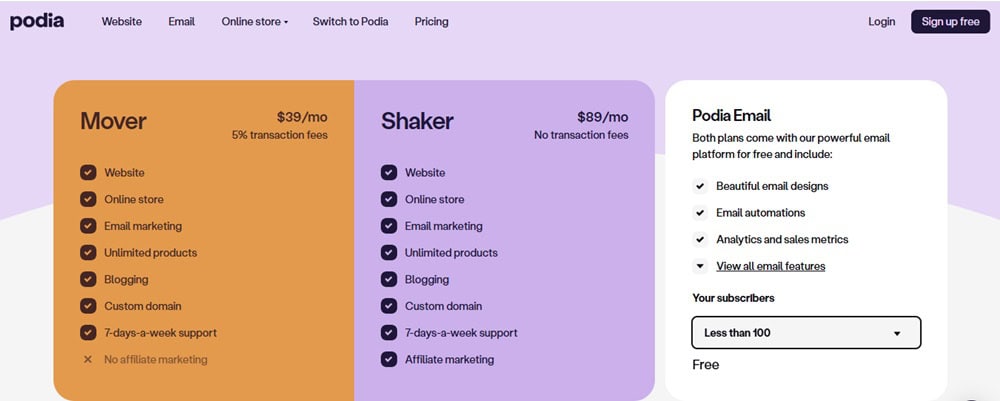
- Mover Plan at $39/month ($33/month billed annually): This plan lets you sell unlimited digital products, host your site, send emails, and run your own community with a 5% transaction fee.
- Shaker Plan at $89/month ($75/month billed annually): This lets you add affiliate marketing tools, advanced email features, and embedded checkout to sell anywhere online. There are no transaction fees.
- Podia Email: This is free and comes with both the mover and shaker plans. This is free for 100 subscribers, and you get email designs, automation, analytics, and sales metrics.
9. Kajabi — Best All-in-One Platform for High-End Course Businesses
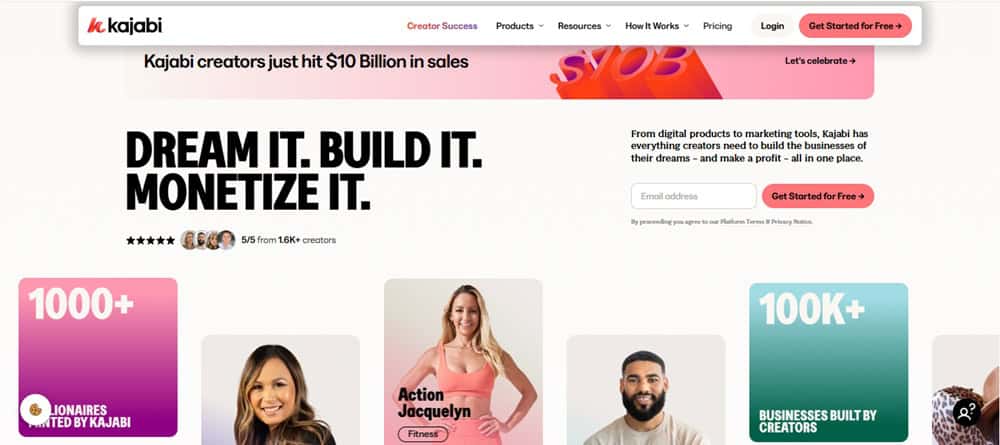
If you want the Rolls-Royce of digital product platforms, Kajabi is it.
This is more than a course builder. Kajabi gives you everything you need to run a full-scale online business: marketing, automation, website, courses, podcasts, checkout, CRM, community… It’s all here, polished and integrated beautifully.
It’s for creators who’ve outgrown patchwork systems and want their brand, delivery, and customer experience to feel next level.
What Makes Kajabi a Great ClickFunnels Competitor
- Stunning Course + Membership Builder: Upload videos, create modules, drip content, and manage students, all in a beautiful, easy-to-navigate space that makes you look like a premium brand from day one.
- Built-In Funnel (Pipeline) Builder: Launch complete funnels with emails, landing pages, sales pages, and thank-you pages already mapped out for you.
- All-in-One Email Marketing Suite: Set up email broadcasts or build smart automations based on behavior. Tag users, track opens, and move them through your funnel, all inside Kajabi.
- Website Builder That Doesn’t Feel Like a Toy: Build a gorgeous, mobile-friendly site for your brand with custom domains, navigation, blogs, and built-in SEO features.
- Checkout + Payment Pages That Convert: Accept payments with Stripe or PayPal, offer coupons, upsells, and multiple payment options, all branded to match your site.
- Built-In CRM to Track Leads and Customers: See what your users are clicking, watching, buying, and where they drop off, so you can respond with the right message at the right time.
- Mobile App for Your Students: Your users can access their content anytime, anywhere.
- Private Community Features (No Facebook Needed): Build a paid or free community space inside Kajabi, beautifully integrated with your products and offers.
What I Love About Kajabi (Pros)
- Truly all-in-one and beautifully integrated: Everything works together — email, courses, funnels, checkout, website.
- Clean, premium user experience: From your admin dashboard to your students’ content portal, everything feels smooth, fast, and well-designed.
- Incredible support + training: Kajabi’s onboarding, tutorials, and support team are top-notch.
- You can run your entire business on Kajabi: From audience building to sales to delivery, it’s all in one place.
- Built for scaling creators: Whether you’re selling a $27 ebook or running a $5K mastermind, Kajabi handles it all beautifully.
- Automations make your business smarter: Tag leads, trigger emails, unlock content, all based on how your audience behaves. Less manual work, more sales.
What’s Not Great About Kajabi (Cons)
- Pricey compared to other tools: Kajabi isn’t cheap, and if you’re starting, it might feel like a stretch.
- Limited design flexibility: The templates are gorgeous, but they’re still templates. If you want ultra-custom layouts, you may feel a bit boxed in.
- No native upsell bump before checkout: You can do post-purchase upsells, but pre-checkout order bumps require a workaround.
How Much Does Kajabi Cost?
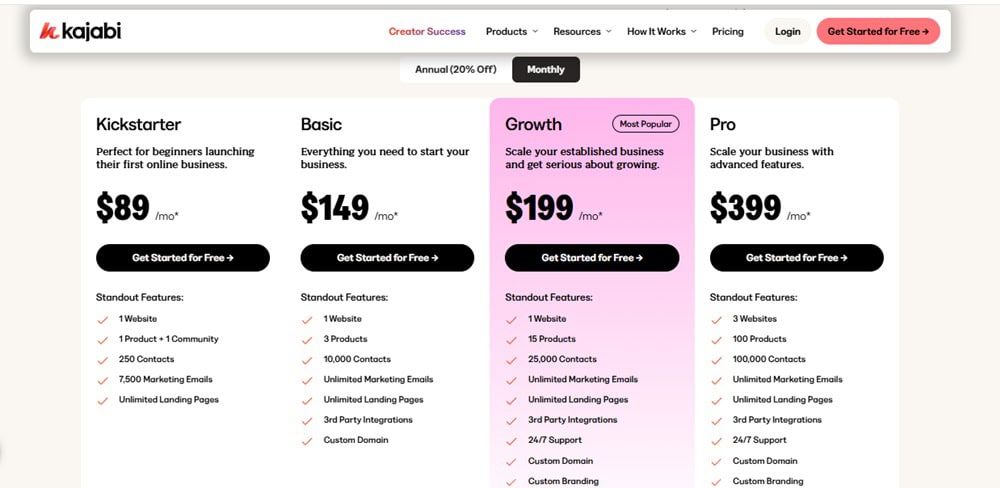
- Kickstarter Plan at $89/month ($71/month billed annually): This is perfect for beginners launching their first online business. You get one website, 1 product, and 250 contacts.
- Basic Plan at $149/month ($119/month when billed annually): This plan gives you everything you need to start your business. You get three products, three funnels, and 10,000 contacts. This includes website, automations, email, and courses.
- Growth at $199/month ($159/month when billed annually): This plan lets you scale your established business and get serious about growing. You get 15 products, 15 pipelines, advanced automations, an affiliate program, and 25,000 contacts.
- Pro at $399/month ($319/month when billed annually): This plan lets you scale your business with advanced features. You get 100 products, 100 funnels, up to 100,000 contacts, and complete white-label branding.
10. Kit (Formerly ConvertKit)
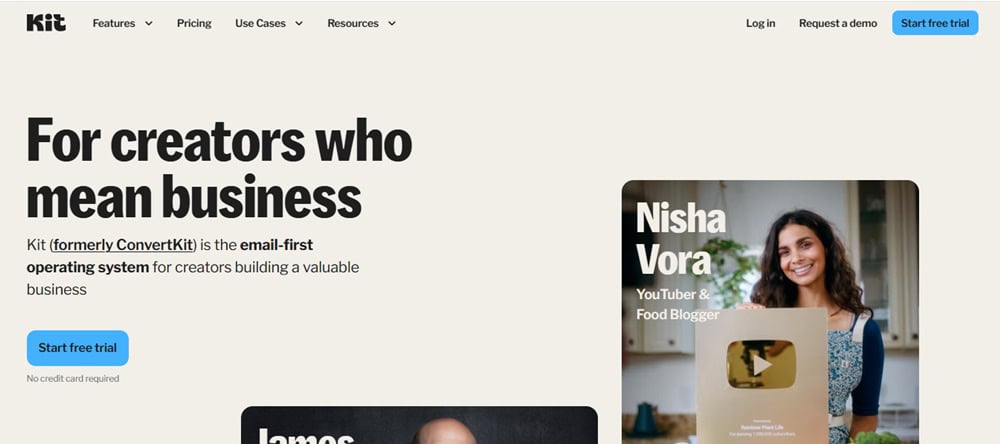
If email is your home base — your newsletter, your digital products, your audience — Kit might be the most natural, no-fuss platform to grow and sell.
This isn’t for complicated funnels or mega-course empires. This is for writers, coaches, musicians, and digital creators who want to connect, serve, and earn, without tech overwhelm.
Think of it as a clean, minimalist workshop for modern creators. It does email beautifully. It sells your stuff simply. And it respects your time.
What Makes Kit a Great ClickFunnels Substitute
- Visual Automation Builder That’s Actually Fun to Use: Set up welcome sequences, launch campaigns, behavior triggers, and more, all from an intuitive, drag-and-drop dashboard that doesn’t make you feel like a developer.
- Creator Profile + Link Page: You get your own public profile with opt-in forms, offers, and links, like Linktree but way more powerful (and actually tied to your email list).
- Built-In Landing Page + Form Builder: Design clean, high-converting landing pages and opt-in forms without needing a website or WordPress.
- Sell Digital Products + Paid Newsletters: Launch your first product without needing Shopify, SamCart, or Teachable.
- Email Marketing Built for Creators: Segment your list by interest or action. Tag subscribers. Send broadcasts or automation sequences.
- Free Community Feature (Kit Sponsor Network): Tap into their creator ecosystem to partner with sponsors and other creators.
- Subscriber Scoring + Reporting: See which subscribers are most engaged, where people drop off, and what content drives clicks and buys.
- Integrations With Everything You Already Use: Easily connect to Gumroad, Teachable, WordPress, Shopify, and more, so ConvertKit fits neatly into your existing flow.
What I Love About Kit (ConvertKit)
- Spotless and intuitive interface: You don’t need tutorials to start sending emails or building automations.
- Perfect for solo creators and side hustlers: You can launch a whole funnel (or close to it), grow your list, and sell digital products, all without hiring help.
- You can start selling in minutes: With their “products” feature, you can literally launch and deliver a digital product or paid newsletter on day one.
- Tagging and segmentation that makes sense: You’ll never feel confused about who’s getting what email.
- Built-in monetization tools: Kit gives you tools to earn from that audience right inside the platform.
- Free plan is generous and actually useful: You can build a real list, send emails, and even create landing pages without spending a dime upfront.
What I Don’t Like About Kit (Formerly ConvertKit)
- No funnel builder or course hosting: You can build basic flows, but if you need complete multi-step funnels or course delivery, you’ll need other tools.
- Limited design options: The templates are clean, but if you want fancy visuals or deep customization, you might feel restricted.
- Advanced automations are only on paid plans: You get the basics for free, but to unlock visual automation and sequences, you’ll need to upgrade.
How Much Does Kit (Formerly ConvertKit) Cost?
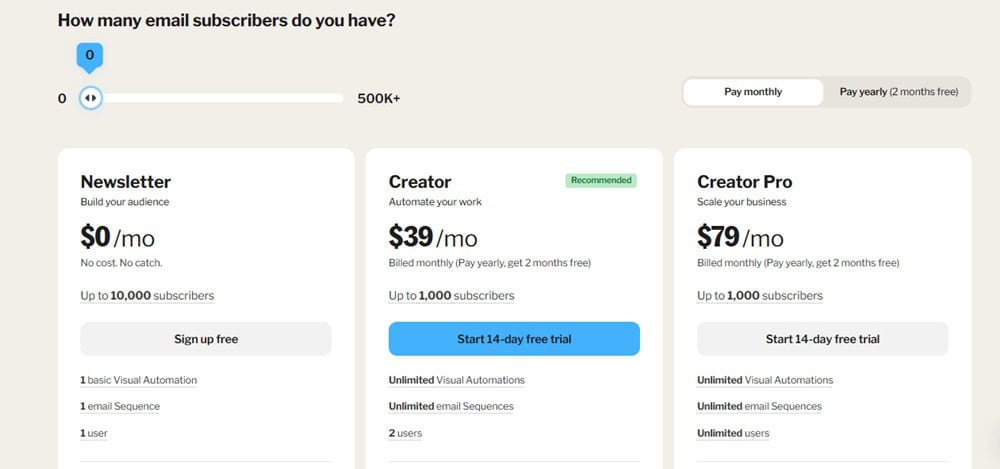
- Newsletter Plan at $0/month: Free for up to 1,000 subscribers. Email broadcasts, opt-in forms, landing pages, and digital product selling are all included.
- Creator Plan: This plan starts at $39 for 1000 subscribers. It unlocks automated sequences, integrations, and a visual automation builder. The price scales with subscriber count.
- Creator Pro Plan: This plan starts at $79/month. It adds subscriber scoring, advanced analytics, deliverability tools, and Facebook custom audience syncing.
11. Wix
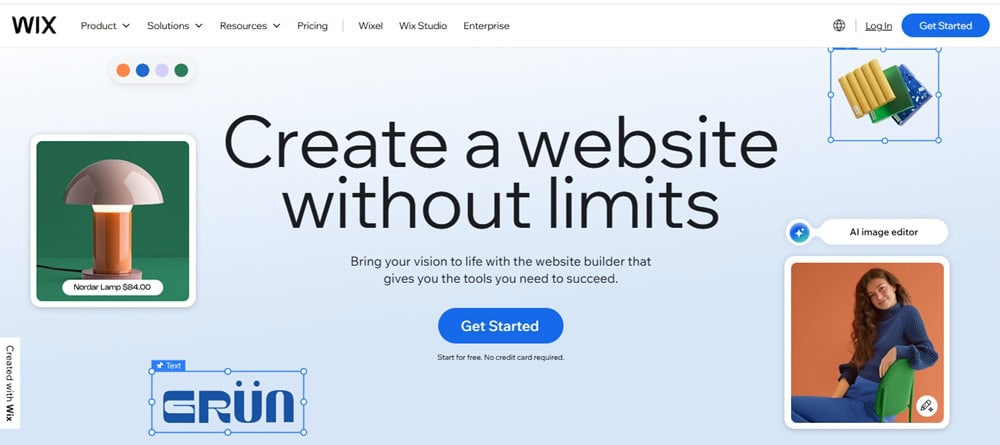
If you’ve ever felt trapped inside a funnel builder’s rigid templates, Wix is the breath of fresh air you didn’t know you needed.
It’s built for creators, freelancers, and small brands who want complete creative control and who don’t want to sacrifice beauty for functionality. With Wix, you can build a stunning website and layer in funnels, email marketing, automations, ecommerce, and more.
It’s not just a website builder anymore, it’s a complete marketing system in disguise.
What Makes Wix a Great Substitute for ClickFunnels
- Actual Drag-and-Drop Page Builder With Pixel-Level Control: Unlike ClickFunnels or most funnel builders, Wix gives you total creative freedom. You design the experience, not just fill in a template.
- Built-In Email Marketing Tools (Wix Ascend): Send broadcasts, create automations, tag leads, and follow up after actions, all inside Wix.
- Funnel Templates + Custom Sales Flows: Set up lead capture pages, thank-you pages, and multi-step funnels with logic, triggers, and built-in analytics.
- Online Store + Digital Product Sales: Sell anything, from courses to physical merch to subscriptions. Manage inventory, taxes, payments, and fulfillment in one place.
- Booking System for Coaches + Service Providers: Let clients book and pay for sessions directly through your site. Includes calendar sync, email reminders, and rescheduling tools.
- Mobile Optimization That Doesn’t Break Your Layout: Design once, and your content auto-adjusts for phones and tablets. No broken mobile views or messy fixes.
- Built-In CRM to Manage Contacts + Automations: Track visitors, segment customers, assign tags, and automate follow-up emails.
- Over 250+ Integrations and App Extensions: Need email, chat, popups, analytics, or quizzes? The Wix App Market gives you plug-and-play extensions to customize your stack.
What I Love About Wix (Pros)
- Unmatched design freedom: You’re not boxed into boring templates. You can fully control how every page looks and feels.
- Everything in one ecosystem: Website, blog, email, ecommerce, automations, it’s all under one login.
- Excellent for service providers: If you book clients, host consultations, or offer packages, Wix’s booking and invoicing tools are a game-changer.
- Solid for selling physical and digital products: Wix supports both use cases well, with clean checkout flows and product management.
- Mobile-first optimization: Your site won’t look wonky on phones, and you can even tweak the mobile version separately if needed.
- App store expands what Wix can do: Want live chat? Quizzes? Social proof popups? There’s probably an app for it, ready to go with one click.
What’s Not So Great About Wix (Cons)
- Funnels aren’t as plug-and-play as ClickFunnels: You can build sales flows, but it’s not designed around “funnels” the way ClickFunnels or GoHighLevel are.
- Speed can suffer with heavy designs: If you get wild with design or use too many apps, your site speed can take a hit, especially on mobile.
- More tools = more learning curve: Wix gives you a lot, but that also means it takes time to learn what’s where and how it all works together.
How Much Does Wix Cost?
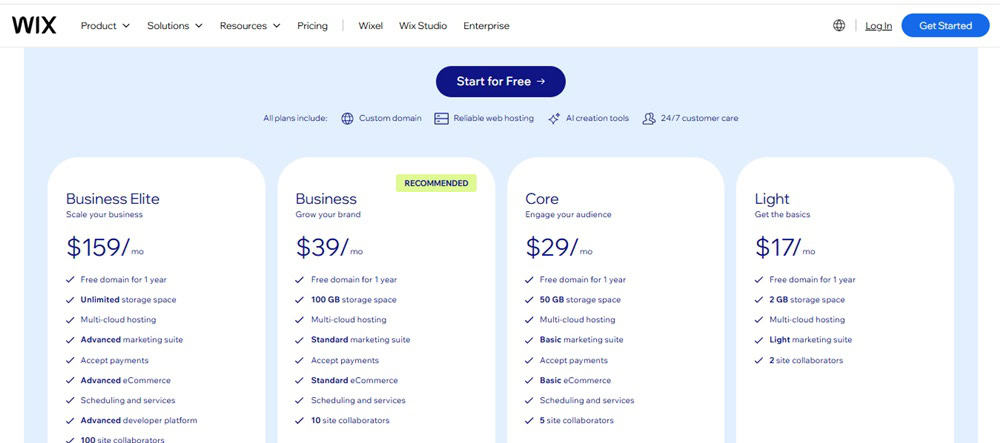
- Free Plan at $0/month: This is good for testing, but includes Wix branding and a non-custom domain.
- Light Plan at $17/month: This removes Wix ads and gives you more bandwidth, perfect for personal brands or portfolios.
- Core at $29/month: This plan includes basic marketing tools, chat, payments, and access to a custom domain, making it ideal for small businesses.
- Business Plan at $39/month: This is best for selling products and services. This plan includes ecommerce tools, analytics, and customer management.
- Business Elite at $159/month: This is built for scaling brands that want advanced automation, performance boosts, and priority support.
12. HubSpot
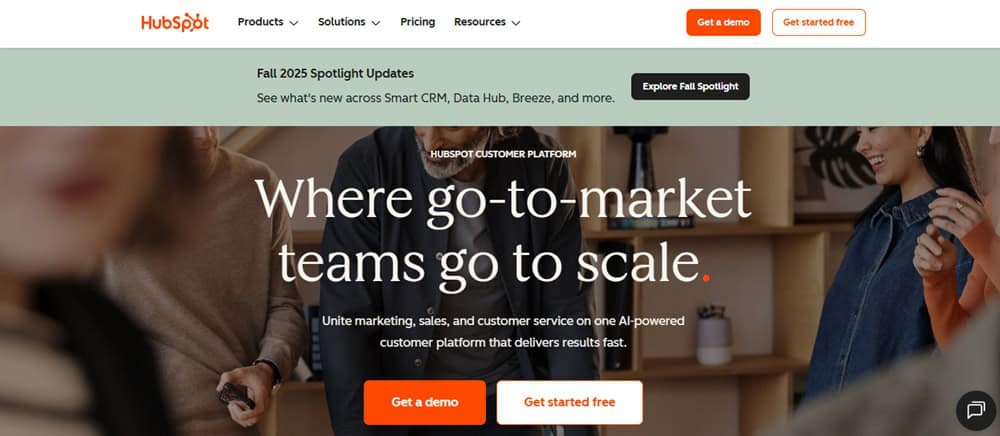
If you’re tired of guessing what your leads are thinking or where they are in your sales process, HubSpot gives you X-ray vision.
HubSpot is an entire marketing, sales, and CRM engine that helps you attract leads, convert them, and keep them coming back.
Whether you’re a solopreneur scaling up or a small team with big goals, HubSpot gives you clarity, automation, and serious growth tools, all in one smart dashboard.
What Makes HubSpot a Strong Alternative to ClickFunnels
- Drag-and-Drop Landing Page Builder: Build stunning, conversion-optimized landing pages without touching code. Use pre-built templates, or design from scratch, all branded to match your business.
- Built-In CRM That Tracks Every Interaction: Know exactly who’s clicking, visiting, replying, or ignoring you.
- Smart Email Automation & Personalization: Send the right message at the right time, based on clicks, visits, or actions. Feels personal. Scales automatically.
- Live Chat, Bots, and Helpdesk Tools: Convert visitors in real time, offer support, or qualify leads with automated bots, all without leaving your site.
- Sales Pipeline + Deal Tracking: Move leads through your custom pipeline, assign tasks to your team, and never forget a follow-up again.
- Pop-Ups + Forms That Feed Your CRM: Capture leads through pop-ups, slide-ins, or embedded forms, and auto-add them to segmented lists with zero extra tools.
- Ad Management + Analytics in One Place: Run Facebook, Google, or LinkedIn ads, and track how those leads perform inside your funnel.
- Detailed Analytics + Lead Scoring: See where your traffic comes from, what converts, and who your hottest leads are, all in one click.
What I Love About HubSpot (Pros)
- You get funnel building and CRM insight together: Most platforms give you one or the other, but HubSpot connects marketing and sales in a seamless loop.
- No more tool-hopping: Email, CRM, pages, forms, chat, support. It’s all native, all connected, and always in sync.
- It’s built to scale with you: Whether you’re solo now or managing a growing team, HubSpot gives you features that grow with your needs.
- Best-in-class lead tracking: You can see every email click, every page visit, every form fill.
- Excellent documentation and support: Their training, academy, and onboarding make it easy to get going, even if you’ve never used a CRM before.
- Built for both sales and marketing: Few tools blend both sides as well as HubSpot does, which means better alignment and more conversions.
What I Don’t Like About HubSpot (Cons)
- Gets expensive fast as you grow: While the free tools are generous, once you start unlocking automation, advanced analytics, or more contacts, pricing jumps quickly.
- It can feel overwhelming at first: With so many tools in one place, new users might need time to learn what does what, especially in the dashboard.
- Not built specifically for digital products or course delivery: You can build funnels, but you’ll need to integrate another platform if you’re selling courses or gated content.
How Much Does HubSpot Cost?
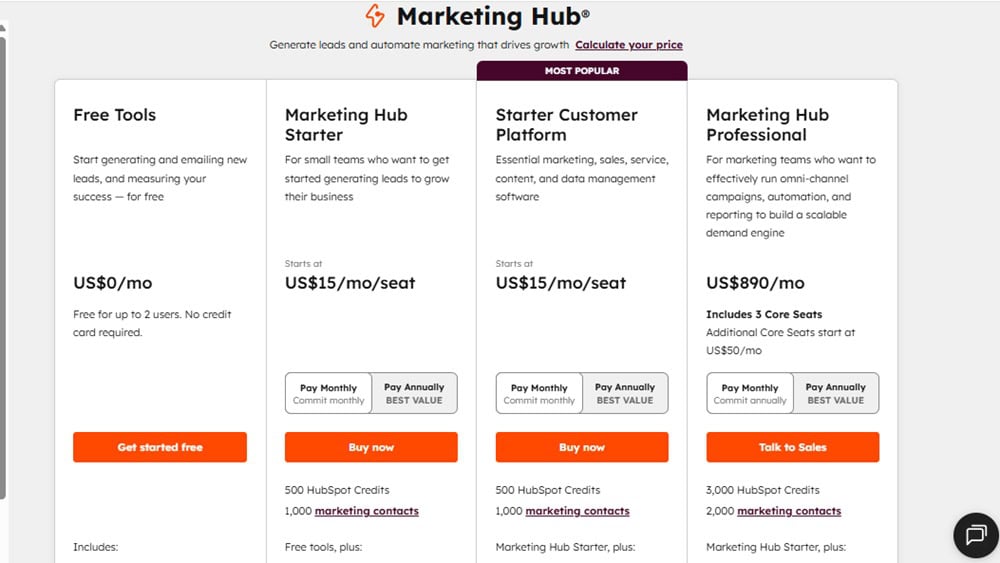
- Free Tools at $0/month: This includes CRM, forms, landing pages, email marketing, and basic automation. Great for getting started.
- Marketing Hub Starter at $15/seat/month: This unlocks email automation, ad tools, and removes HubSpot branding from your assets.
- Starter Customer Platform at $15/seat/month: This adds pipeline tools, live chat, ticketing systems, and more based on your business needs.
- Marketing Hub Professional at $890/month: This adds advanced automation, smart content, A/B testing, and campaign reporting. Built for growing businesses.
13. Shopify — Best for Ecommerce Businesses
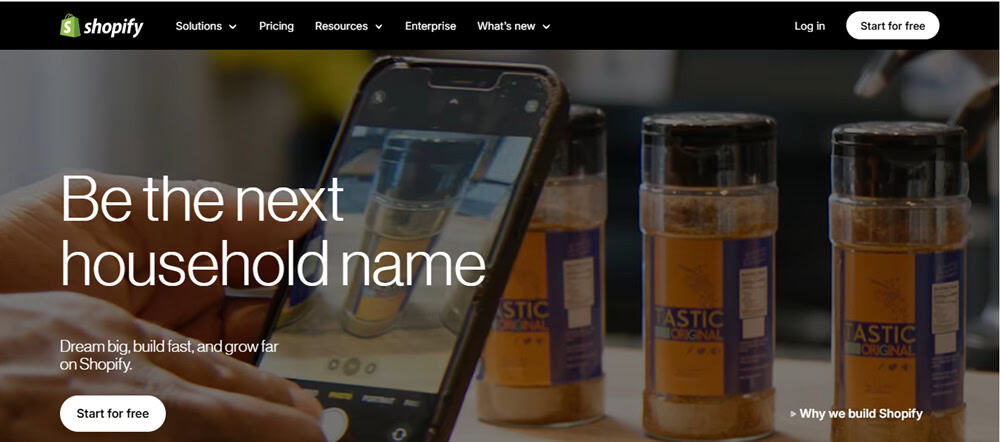
If you’re building an actual store, not just a single-product funnel, Shopify gives you the firepower to go from idea to online empire.
It’s built to sell fast, globally, and at scale. You get gorgeous storefronts, lightning-fast checkouts, upsells, abandoned cart recovery, and apps for almost anything.
It’s like ClickFunnels, but for serious ecommerce brands.
What Makes Shopify a Strong Competitor to ClickFunnels
- Beautiful, Customizable Storefronts: Choose from premium templates or build your own branded shop from scratch.
- Mobile-Optimized, High-Speed Checkout: Shopify’s checkout is built for conversions. It is fast, smooth, and trusted worldwide. Apple Pay, Google Pay, PayPal? All included.
- 1-Click Upsells, Cross-Sells & Smart Recommendations: Increase your average order value with product suggestions, bundling tools, and cart add-ons that feel natural.
- Abandoned Cart Recovery That Actually Works: Automatically email visitors who bounce before buying, and win back a chunk of lost revenue with zero manual follow-up.
- Built-In Blogging + SEO Tools: Attract organic traffic, rank on Google, and turn content into sales. Shopify isn’t just a store; it’s a complete content platform.
- Shopify App Store (4,000+ Apps): Want to build funnels, offer quizzes, use timers, run memberships, or sell courses? There’s probably an app for that, and it plugs in instantly.
- Multi-Channel Selling (IG, TikTok, Amazon, Etsy): Sell on your website, social, and marketplaces, and manage it all from one dashboard.
- Analytics That Show You What’s Working: Track product performance, customer behavior, top funnels, traffic sources, and make smarter decisions with real data.
What’s Great About Shopify (Pros)
- Built for selling, not just collecting leads: While ClickFunnels focuses on opt-ins, Shopify focuses on actual purchases, inventory, and fulfillment.
- Fast, reliable, and trusted by buyers: Millions of people buy from Shopify stores, and your customers trust the checkout flow instantly.
- Endless customization through apps: You’re never boxed in. Need upsells, subscriptions, reviews, bundling, funnels? The app store covers you.
- Scales effortlessly as you grow: Whether you’re selling one product or 10,000, Shopify’s infrastructure handles it without you needing to “upgrade” every week.
- Solid SEO and blogging tools: You’re not just stuck with paid ads. Build organic traffic with content that brings buyers in for free.
- Built-in fraud analysis and security: Protects you and your buyers without extra tools so that you can focus on sales, not cybersecurity.
What’s Not So Great About Shopify (Cons)
- Relies heavily on third-party apps: Out of the box, Shopify is powerful, but to get proper “funnel” features, you’ll likely need a few paid add-ons.
- Design flexibility has limits: If you don’t code, you’re limited to what the theme and app allow. Customizing layouts can get tricky without help.
- Not ideal for info-only businesses: If you don’t sell a physical or digital product, Shopify might feel overkill, especially for coaches or service providers.
How Much Does Shopify Cost?
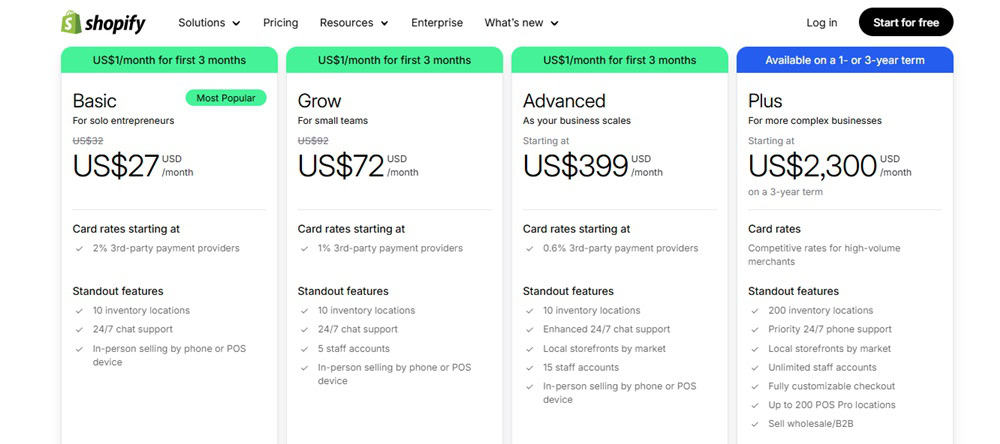
- Starter at $5/month: This lets you sell via social media or messaging apps with a link, no full storefront.
- Basic at $27/month ($19/month billed annually): Launch your store with all core features: products, checkout, blogging, email marketing, and basic reports.
- Grow at $72/month ($54/month billed annually): This is great for small teams with five staff accounts.
- Retail Plan at $89/month: This gives you in-person selling tools with advanced staff, inventory, and loyalty features.
- Advanced at $399/month ($299/month billed annually): This includes custom reports, more automation, and lower processing fees, making it outstanding for scaling brands.
- Plus Plan Starting at $2300/month (on a 3-year term): This plan is for more complex businesses with unlimited staff accounts and wholesale/B2B functionalities.
14. OptimizePress — Best for WordPress Users
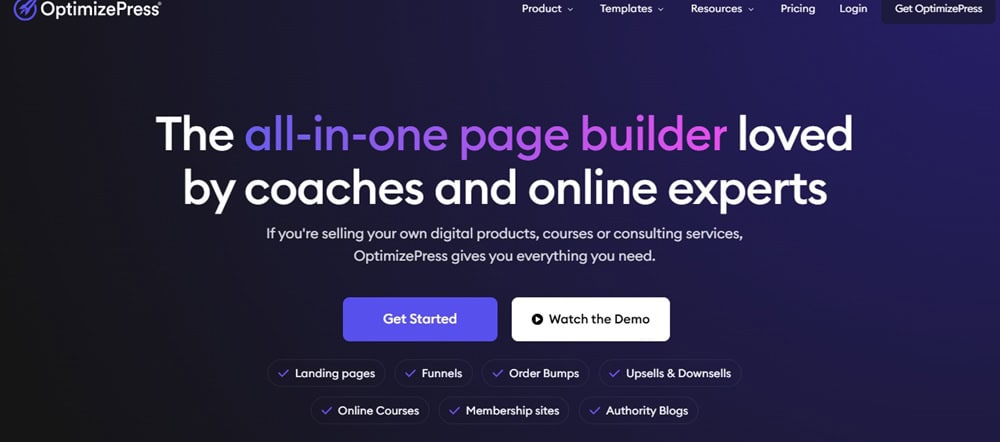
If you’re already on WordPress and tired of sending your traffic off-site to build funnels, OptimizePress brings the power of ClickFunnels right into your own website.
Build funnels, sales pages, opt-ins, memberships, and checkouts, all under your domain, with your branding, and with zero recurring fees.
What Makes OptimizePress a Great Substitute to ClickFunnels
- Drag-and-Drop Funnel Builder Inside WordPress: Create opt-in pages, sales pages, upsells, and thank-you pages, all visually, directly inside your WP dashboard.
- Hosted Checkout With Stripe + PayPal Integration: Sell products, services, or memberships directly, with built-in checkout pages that look clean and convert like crazy.
- Built-In Funnel Templates With High Conversions: Launch quickly with professionally designed funnel layouts that are tested for performance, or build your own from scratch.
- 1-Click Upsells + Order Bumps: Boost order value instantly by offering complementary products post-purchase or as bump offers at checkout, just like ClickFunnels, but in WordPress.
- Email & CRM Integration Ready: Connect with your favorite tools like ActiveCampaign, ConvertKit, Mailchimp, or Drip, so leads flow smoothly into your existing system.
- Membership Site Builder (OptimizeMentor): Protect content, drip lessons, lock access; everything you need to run a course or private content hub from inside WordPress.
- Landing Pages Optimized for Speed + SEO: OptimizePress is built lean, meaning your pages load fast, rank better, and feel more trustworthy for cold traffic.
What You’ll Love About OptimizePress (Pros)
- Total control inside your WordPress site: Everything stays in one place, under your domain, and in your complete control.
- Great for course creators and coaches: With OptimizeMentor, you can build and sell a full membership or course site without any third-party platforms.
- Clean templates that are conversion-focused: You’re not left designing from scratch.
- Fast loading pages with SEO in mind: Unlike many funnel builders, OptimizePress doesn’t slow down your site, which is enormous for conversions and ranking.
- Affordable, especially for long-term use: Over time, it’s one of the cheapest ways to build and manage funnels, especially if you’re already using WordPress.
What I Don’t Like About OptimizePress (Cons)
- Only works on WordPress: If you’re not a WordPress user, this won’t work for you. No Wix, no Shopify, no Squarespace support.
- Lacks built-in email or CRM tools: You’ll need to connect your own email marketing platform; it doesn’t include one natively.
- Not as beginner-friendly as hosted platforms: You’ll need to know your way around WordPress basics — plugins, updates, themes — which can overwhelm some users.
How Much Does OptimizePress Cost?
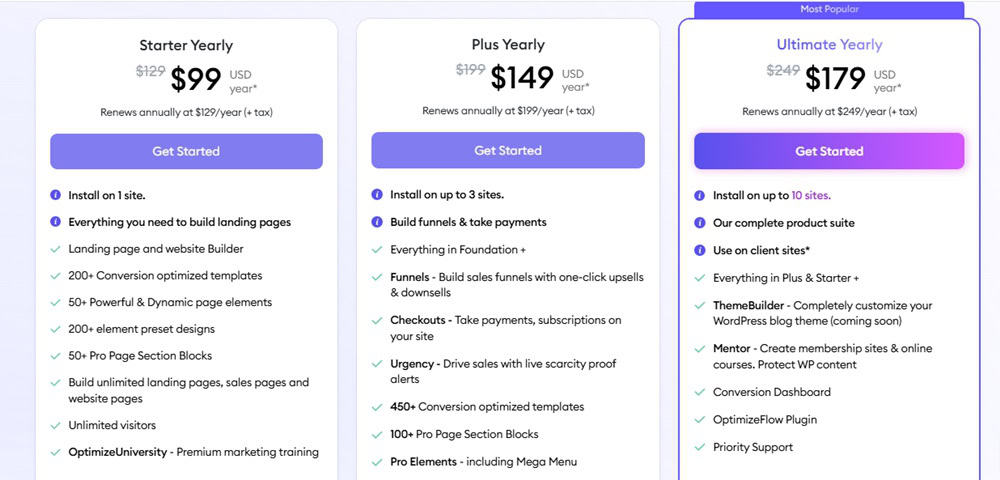
- Starter Yearly Plan at $99/year (Renews annually at $129/year): This includes the page builder, funnel templates, and one-site license. Great for solopreneurs.
- Plus Yearly Plan at $149/year (Renews annually at $199/year): This includes OptimizeFunnels, checkout tools, and comprehensive marketing functionality. It can be used on up to 3 sites.
- Ultimate Yearly Plan at $179/year (Renews annually at $249/year): This includes everything in the Plus Plan, OptimizeMentor, and theme builder. It can be used on up to 10 sites, and it is ideal for freelancers or marketers managing multiple brands.
15. CartFlows — Best for WordPress + WooCommerce Users

If you’re running an online store on WordPress and WooCommerce but wish it had ClickFunnels-style sales flows, CartFlows makes that dream a reality.
This plugin transforms your basic ecommerce setup into a full-blown, optimized funnel machine, complete with upsells, downsells, order bumps, custom checkouts, and beautiful landing pages.
What Makes CartFlows a Great Competitor to ClickFunnels
- One-Click Sales Funnels Built Into WordPress: Create multi-step sales funnels — opt-in, checkout, upsell, downsell, thank-you — all using drag-and-drop blocks within your favorite page builder (like Elementor or Gutenberg).
- Optimized Checkout Pages That Actually Convert: Replace WooCommerce’s boring, default checkout with a clean, distraction-free design built for one thing: getting the sale.
- Order Bumps + 1-Click Upsells/Downsells: Boost your average order value instantly by offering add-ons during or after checkout, with just one click.
- Pre-Built Funnel Templates to Launch Fast: Choose from high-converting layouts that are ready to plug in and customize, no need to build from scratch.
- Dynamic Thank-You Pages With Offers or Next Steps: Customize post-purchase pages to drive more engagement, cross-sells, or send customers into the next funnel.
- Real-Time Cart Abandonment Tracking + Recovery: See who drops off before buying and recover the sale with follow-up offers and email reminders.
- Compatible With Stripe, PayPal, & Subscription Plugins: Accept payments, run recurring billing, and manage transactions inside WooCommerce, all enhanced by CartFlows.
What I Love About CartFlows (Pros)
- Makes WooCommerce a real funnel builder: Most stores “sell stuff”, CartFlows lets you sell smart with funnels, upsells, and buyer psychology baked in.
- Works with page builders you already know: Whether you love Elementor, Divi, or Gutenberg, CartFlows plugs right in and keeps your workflow familiar.
- Pre-built funnels save you hours: Pick a template, tweak the copy, and go live. It’s super beginner-friendly for a WordPress plugin.
- Great for physical and digital products: Whether you’re shipping T-shirts or selling coaching calls, CartFlows adapts and optimizes your checkout.
- Powerful add-ons + community support: With the Pro version, you get advanced features and access to a passionate user base always sharing tips and ideas.
What’s Not So Great About CartFlows (Cons)
- Requires WooCommerce + WordPress: If you’re not already using WordPress and WooCommerce, CartFlows won’t work for you; it’s not a standalone platform.
- Design flexibility depends on your builder: If your page builder is clunky or outdated, you might feel limited in design freedom.
- Extra plugins can bloat your site: Adding too many funnel tools on WordPress can slow things down; you’ll need good hosting and a lean setup.
How Much Does CartFlows Cost?
- Free Plan at $0/month: This includes one checkout funnel, order bump, checkout editor, and basic templates, a solid way to test it out.
- CartFlows Plus Plan at $189/year (Renews annually at $249/year): This is perfect for stores that want to increase their average order value. It is ideal for new WooCommerce stores looking to boost sales quickly.
- CartFlows Pro Plan at $299/year (Renews annually at $449/year): This unlocks unlimited funnels, upsells/downsells, advanced checkout features, dynamic offers, A/B testing, and premium templates.
- CartFlows Pro Lifetime Plan at $999/year: You get all the features of the Pro plan forever.
How I Assessed Alternatives to ClickFunnels
Picking a funnel builder isn’t like choosing between Coke and Pepsi.
It’s more like choosing the engine of your online business. If it’s slow, clunky, or can’t scale, you’re not just stuck, you’re stalled.
When I started testing ClickFunnels’ competitors, I didn’t just skim features or pricing pages. I used them as a real user would.
I tried building funnels. I pretended I was launching a product tomorrow. I made decisions the way you probably would, asking questions that actually matter.
How fast can I go from idea to live funnel?
Some tools are like building IKEA furniture without instructions. You know it can be done, but by the time you’re done, you’re questioning your life choices.
For me, speed is everything.
I wanted tools that made it possible to go from a blank page to a finished, launch-ready funnel today, not next week.
No extra tech. No team required. Just plug, play, publish.
Can I actually sell something with this, or is it just pretty?
A funnel builder has one job: to convert. So I tested the checkout flow like a customer.
Is it smooth? Does it feel trustworthy? Can I add order bumps or upsells without jumping through hoops?
If the buying experience felt clunky or sketchy, it didn’t make the cut. If I wouldn’t trust it with my own money, I’m definitely not recommending it for yours.
Does it play nicely with the rest of my stack?
Switching tools shouldn’t mean blowing up your whole system.
I looked for platforms that integrated easily with email tools, CRMs, payment processors, and other apps most of us already use.
If it couldn’t connect without jumping through API hoops or third-party zaps, it was a no-go.
The best tools click into place like puzzle pieces, not duct tape.
Is this thing built to grow with me?
Some platforms are like starter bikes: great for learning, but not built for the highway.
I looked for tools that wouldn’t fall apart when your list hits 10,000 or you’re running a 5-product business.
Can you upgrade features? Handle more traffic? Add team members or new products without starting over?
If the platform flatlined under pressure, it didn’t make the list.
How does it actually feel to use it daily?
Some tools look great on the sales page, and then you log in and want to scream.
I paid close attention to the vibe. Is it intuitive? Does it load fast? Do things make sense, or do I need a YouTube tutorial for every click?
A tool you hate using becomes a tool you stop using. So if it wasn’t enjoyable (or at least frictionless) to work with, it didn’t stay on the list.
Final Thoughts: Why GoHighLevel Stands Above the Rest
If you’ve made it this far, you’re clearly not just looking for any ClickFunnels alternative. You want a smarter, faster, more powerful platform that actually helps you build and grow a real business.
And if that’s what you’re after, GoHighLevel is the clear winner. Why?
Because it obliterates the need for five other tools you’re probably duct-taping together right now. You get the funnels. You get the CRM. You get the automations, calendars, SMS, email, AI assistant, and white-label SaaS — all under one roof.
No more tool fatigue. No more monthly subscriptions stacked a mile high. No more wondering if your leads actually got that follow-up email.
GoHighLevel turns your funnel into a system that runs 24/7, grows with you, and frees you up to do what matters: sell, scale, and serve your audience.
Frequently Asked Questions on ClickFunnels Alternatives
What exactly does ClickFunnels do?
ClickFunnels is like a digital assembly line for selling stuff online. You can build landing pages, collect leads, sell products or services, and guide your visitors through a sales funnel.
How much is ClickFunnels per month?
ClickFunnels starts at $97/month for the Launch plan. If you want access to their full suite of tools, including advanced funnels, analytics, and more team members, you’re looking at $297/month for the Optimize plan.
Is HighLevel better than ClickFunnels?
Yes, HighLevel is better than ClickFunnels, especially if you want more than just a funnel builder. GoHighLevel gives you funnels, yes. But it also gives you a built-in CRM, email + SMS marketing, appointment scheduling, review management, AI features, and the ability to resell the entire platform as your own SaaS business.
What is the best free alternative to ClickFunnels?
The best free alternative is hands down Systeme.io. You can build sales funnels, send emails, sell digital products, and even run a course, all for $0/month.
Is WordPress better than ClickFunnels?
If you want total control, own your site, and avoid monthly fees, WordPress is amazing. Especially when paired with tools like OptimizePress or CartFlows, you can build serious funnels on your own turf. But if you’re not tech-savvy or don’t want to deal with hosting, plugins, or updates, ClickFunnels might feel easier out of the box.
Is Kartra better than ClickFunnels?
Kartra is like ClickFunnels, but with additional features such as email marketing, membership sites, calendars, video hosting, and helpdesk tools, all integrated. If you’re looking for an all-in-one solution to sell, automate, and deliver your product, Kartra gives you more functionality right out of the box.
Check out other Related posts:

